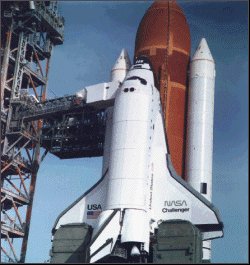|
|
|
CHALLENGER
|
 |
OV-099
completed at this: June 30th, 1982
Maiden flight on this: April 4th, 1983
|
At first for eleven months the second space shuttle, Challenger (OV 099),
taken into operation served at thorough vibration tests as a test object
true to the original before it was rebuilt to a spacecraft fully fit to fly.
The Challenger was named after a research vessel of the US-Navy which drove
at 1875 at the Atlantic and the Pacific and had already given its name to
the lunar module Apollo 17, too. The Challenger left the Rockwell production
plants in Palmdale on June 30th, 1982 and was flown to the Kennedy Space
center some days later. Its first flight planned for January was delayed
April 1983. of these use, the sixth flight up to 4 the first of the only ten
Challenger missions was on for the shuttle row, because of fuel leaks to the
main jet engines and problems with the payload. The tenth flight in a
catastrophe as which Orbiter exploded shortly after the start ended in
January 1986. The seven-headed crew was killed. During a space flight,
before, a U.S. astronaut had never been killed. On its ten flights the
Challenger orbited altogether the earth //num(987) mal// and spent in the
space more than 69 days. At these uses some remarkable first performances
were successful: On the maiden flight (STS 6) the first tracking and data
transmission satellite (TDRS 1) was stopped and the new shuttle spacesuit
Musgrave tested Donald person Und story. On the second flight (STS 7) Sally
Ride became the first American in the space. At third use (STS 8) night
start and night landing were successful for the first time. At the fourth
flight (STS 41-B) Bruce McCandless as the first astronaut floated freely
without safeguarding cord by the space. He left the Orbiter with his free
flight-maneuvering unit of (MMU) about thirty meters. At the conclusion of
this successful mission the landing of the space shuttle took place for the
first time on the piste of the Kennedy-Space center. The free
flight-maneuvering unit was in the center, as the astronaut George Nelson
Und James hoped for Van this capture and Max solarly succeeded the repair of
the deficient satellite also at next use (STS 41-C). In addition, the
Langzeitexperimententräger "LDEF" was stationed on an earth orbit. On the
sixth Challenger mission Sally Ride was on board for the second time and
Kathryn Sullivan did a spacewalk as the first American. On the next three
Challenger flights in the year 1985 the space laboratory Spacelab formed the
payload. On the flight STS 51-B the crew of the Spacelab 3 carried two
monkeys and 24 rats. At the mission STS 51 F the pallet payload contained
Spacelab 2 one "igloo" with automatic rule systems. Although the start
couldn't be brought to an end after an early burning end of a main jet
engine as planned, an orbit was reached. On its last flight (STS 61 A)
completed successfully the space shuttle transported this for space lab
Spacelab D1 (Germany 1) on a mission which is mainly by the Federal Republic
planned and financed. With eight astronauts this one was the tallest crew on
board till now. The tenth and last Challenger flight (STS 51 L) on January
28th, 1986 carried the epithet "teacher flight" since the teacher Christa
McAuliffe who should for the first time form lessons of the space for
trainees on the earth belonged to the crew. She didn't arrive, however, any
more: For only 73 seconds to a start been successful apparently perfectly it
came to an explosion and the Challenger went up in a gigantic fireball. None
of the seven crew members survived. Apart from Christa McAuliffe Richard
Scobee, Michael Smith, Judith Resnik, Ellison Onizuka, Ronald McNair and
Gregory Jarvis died in the flames. The message shook the American public and
all shuttle flights got prepared for uncertain time. A large-scale rescue
action with which the ruins of the Challenger should be tracked down out of
the waters in front of cape Canaveral began at the same time. Within the
next seven months almost the half of the Orbiters was found and held. After
an incoming examination one transported the remains of the formerly
impressive Orbiters Challenger into an empty Minutemahn rocket complex of
Air Force on cape Canaveral. The ruins kept since then there are quiet
admonishers to the ubiquitous danger to whom every spaceman exposes himself.
|
The flights of the Challenger:
1 04 Apr 83
STS-6
2 18 Jun 83
STS-7
3 30 Aug 83
STS-8
4 03 Feb 84
STS-41-B
5 06 Apr 84
STS-41-C
6 05 Okt 84
STS-41-G
7 29 Apr 85
STS-51-B
8 29 Jul 85
STS-51-F
9 30 Okt 85
STS-61-A
10 28 Jan 86
STS-51-L |

Challenger,
the second space shuttle built for the flight to space, waits for the
start ... on the launching pad for its maiden flight (STS 6) on April 4th,
1983... |
|

On January
28th, 1986 the Challenger explodes for 73 seconds to the start, all seven
crew members die (STS 51 L) ... ... |
|
|
|